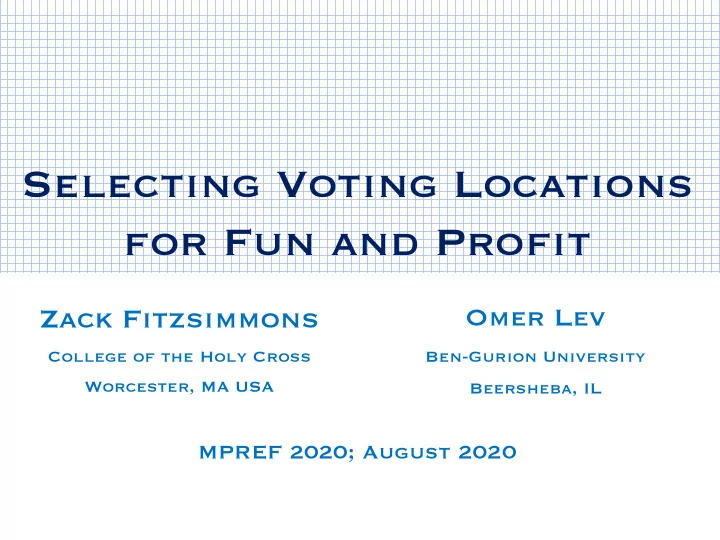

Selecting Voting Locations for Fun and Profit Omer Lev Zack Fitzsimmons College of the Holy Cross Ben-Gurion University Worcester, MA USA Beersheba, IL MPREF 2020; August 2020
Introduction Manipulative attacks on elections are well- studied problems. Only recently has geographic information been used (e.g., gerrymandering [Lewenberg et al., 2017]). We consider how selecting where voters can cast their votes can be used to manipulate. 1/13
Motivation 2/13
Motivation 2/13
Geographic Elections Voters and voting locations are distributed on a metric space. Each voter has a distance-bound and casts their vote only if they are within this bound to a voting location. Each voter has preferences over a given set of candidates. 3/13
Example Plurality election with candidates: { 🍐 , 🍈 } v 4 v 2 v 3 v 5 v 1 4/13
Example Plurality election with candidates: { 🍐 , 🍈 } v 4 v 2 v 3 v 5 v 1 4/13
Example Plurality election with candidates: { 🍐 , 🍈 } v 4 v 2 v 3 v 5 v 1 🍐 wins! 4/13
Polling Place Control Voters and voting locations are distributed on a metric space. Ea Each vote ter r has a dis ista tance it it is is wi willing to o go o to o vot vote. For an election and a set of possible voting locations. Does there exist a s a set o of at at l leas ast k vot voting loca ocation ons , such that a given candidate wins? 5/13
Two Parties: Voters on a line Select at least 2 polling places such that 🍐 wins? L 2 L 1 L 3 x3 x2 x2 x3 x6 v 1 v 8 v 14 v 4 v 6 v 10 v 12 Greedy approach Margin for 🍐 , L 1 : -1, L 2 : -2, L 3 : -3. 6/13
Two Parties: Voters on a line Select at least 2 polling places such that 🍐 wins? L 2 L 1 L 3 x3 x2 x2 x3 x6 v 1 v 8 v 14 v 4 v 6 v 10 v 12 Greedy approach Margin for 🍐 , L 1 : -1, L 2 : -2, L 3 : -3. Would incorrectly return no solution! 6/13
Two Parties: Voters on a line Select at least 2 polling places such that 🍐 wins? L 2 L 1 L 3 x3 x2 x2 x3 x6 v 1 v 8 v 14 v 4 v 6 v 10 v 12 Greedy approach Margin for 🍐 , L 1 : -1, L 2 : -2, L 3 : -3. Would incorrectly return no solution! 🍐 wins when choosing L 2 and L 3. 6/13
Two Parties: Voters on a line Select at least 2 polling places such that 🍐 wins? L 2 L 1 L 3 x3 x2 x2 x3 x6 v 1 v 8 v 14 v 4 v 6 v 10 v 12 Greedy approach In P using dynamic programming Margin for 🍐 , L 1 : -1, L 2 : -2, L 3 : -3. Would incorrectly return no solution! 🍐 wins when choosing L 2 and L 3. 6/13
Two Parties: Voters on the Plane NP-completeness result on the plane is shown by a reduction from Cubic Planar Vertex Cover [Garey and Johnson, 1977]. 7/13
Two Parties: Voters on the Plane We show a variant with all edges on integer gridlines (of length 1 or 1.5) is NP-complete. 8/13
Two Parties: Voters on the Plane We show a variant with all edges on integer gridlines (of length 1 or 1.5) is NP-complete. 8/13
Two Parties: Voters on the Plane We show a variant with all edges on integer gridlines (of length 1 or 1.5) is NP-complete. 8/13
Two Parties: Voters on the Plane We show a variant with all edges on integer gridlines (of length 1 or 1.5) is NP-complete. 8/13
Two Parties: Voters on the Plane We show a variant with all edges on integer gridlines (of length 1 or 1.5) is NP-complete. 8/13
Two Parties: Voters on the Plane For each edge we construct: 0.375 0.375 0.375 u v v 1 v 2 v 3 v 5 v 4 Add an additional polling place > 1.5 from the constructed graph with k voters for 🍐 . Ask if there exists a way to select at least #edges + 1 polling places such that 🍐 wins. 9/13
Two Parties: Results In P on the line using dynamic programming. NP-complete on the plane even when voters can vote at most at 3 locations with same distance-bound. In P on the plane for some natural restrictions (e.g., vote at most at 1 location). 10/13
Two Parties: Results In P on the line using dynamic programming. NP-complete on the plane even when voters can vote at most at 3 locations with same distance-bound. In P on the plane for some natural restrictions (e.g., vote at most at 1 location). Also holds for destructive cases 10/13
Multi-Party: Results For more than two candidates, even on the line, polling place control for plurality is NP-complete. Moreover, the optimization version of this problem is inapproximable within any constant factor. 11/13
Other control actions Attempting to change winner by changing voters’ distance-bound. In P for plurality by adapting the result for priced adding/deleting voter control [Miasko and Faliszewski, 2016]. 12/13
Other control actions Attempting to change winner by changing voters’ distance-bound. In P for plurality by adapting the result for priced adding/deleting voter control [Miasko and Faliszewski, 2016]. Possible application: Buses? 12/13
What’s next? Complexity of polling place control where voters can vote at most at two locations. Experimental study of our polling place control problem. New models that include geographic information. 13/13
What’s next? Complexity of polling place control where voters can vote at most at two locations. Experimental study of our polling place control problem. New models that include geographic information. Thank you! 13/13
Recommend
More recommend